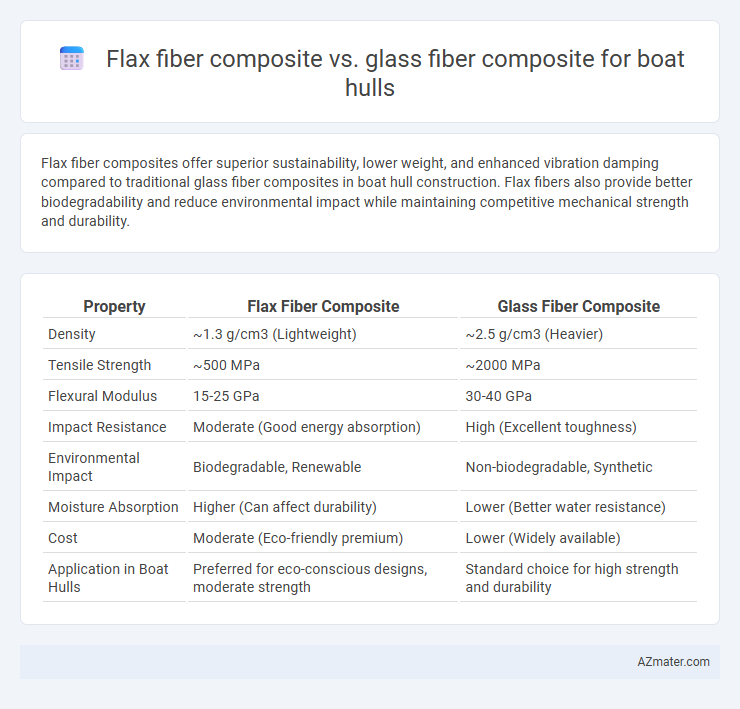Flax fiber composites offer superior sustainability, lower weight, and enhanced vibration damping compared to traditional glass fiber composites in boat hull construction. Flax fibers also provide better biodegradability and reduce environmental impact while maintaining competitive mechanical strength and durability.
Table of Comparison
| Property | Flax Fiber Composite | Glass Fiber Composite |
|---|---|---|
| Density | ~1.3 g/cm3 (Lightweight) | ~2.5 g/cm3 (Heavier) |
| Tensile Strength | ~500 MPa | ~2000 MPa |
| Flexural Modulus | 15-25 GPa | 30-40 GPa |
| Impact Resistance | Moderate (Good energy absorption) | High (Excellent toughness) |
| Environmental Impact | Biodegradable, Renewable | Non-biodegradable, Synthetic |
| Moisture Absorption | Higher (Can affect durability) | Lower (Better water resistance) |
| Cost | Moderate (Eco-friendly premium) | Lower (Widely available) |
| Application in Boat Hulls | Preferred for eco-conscious designs, moderate strength | Standard choice for high strength and durability |
Introduction to Fiber-Reinforced Composites in Boatbuilding
Fiber-reinforced composites, such as flax fiber and glass fiber composites, serve as essential materials in modern boat hull construction due to their high strength-to-weight ratios and corrosion resistance. Flax fiber composites offer sustainable, biodegradable alternatives with good mechanical properties and enhanced vibration damping compared to traditional glass fiber composites. Glass fiber composites remain widespread for their superior tensile strength, cost-effectiveness, and proven durability in marine environments.
Overview of Flax Fiber Composite Materials
Flax fiber composite materials offer a sustainable and lightweight alternative to traditional glass fiber composites for boat hull construction, featuring high specific strength and excellent vibration damping properties. These natural fibers contribute to reduced environmental impact due to their biodegradability and lower energy consumption during production. Flax composites exhibit good mechanical performance and increased moisture resistance when combined with advanced resins, making them suitable for marine applications requiring durability and eco-friendliness.
Overview of Glass Fiber Composite Materials
Glass fiber composite materials are extensively used in boat hull construction due to their high strength-to-weight ratio, corrosion resistance, and affordability. These composites consist of glass fibers embedded in a polymer matrix, typically epoxy or polyester resin, offering excellent mechanical properties and durability in marine environments. Their superior impact resistance and ease of fabrication make glass fiber composites a preferred choice for producing lightweight, robust, and long-lasting boat hulls.
Mechanical Strength and Durability Comparison
Flax fiber composites offer lower tensile strength and flexural modulus compared to glass fiber composites, typically ranging from 50-90 MPa in tensile strength versus glass fiber's 200-350 MPa, impacting load-bearing capacity in boat hulls. Durability-wise, glass fiber composites exhibit superior resistance to moisture absorption, UV degradation, and chemical exposure, resulting in longer service life and less maintenance for marine environments. Flax fibers provide better biodegradability and reduced environmental impact but require enhanced resin matrices or treatments to approach the mechanical robustness and durability performance of glass fiber composites in hull applications.
Weight and Density Considerations
Flax fiber composites exhibit significantly lower density, approximately 1.4 g/cm3, compared to glass fiber composites, which range around 2.5 g/cm3, leading to lighter boat hulls that improve fuel efficiency and handling. The reduced weight of flax fiber composites contributes to enhanced buoyancy and easier maneuverability, critical factors in marine vessel performance. Although glass fiber offers superior strength-to-weight ratios, flax composites provide a sustainable, lightweight alternative with competitive mechanical properties for boat hull construction.
Environmental Impact and Sustainability
Flax fiber composites offer a significantly lower environmental impact compared to glass fiber composites due to their renewable nature and biodegradability, reducing landfill waste and carbon footprint. The cultivation of flax plants absorbs CO2, promoting carbon sequestration, while glass fiber production is energy-intensive and involves non-renewable resources. Flax composites also enable end-of-life recyclability and safer disposal, making them a more sustainable choice for boat hull manufacturing.
Cost Analysis: Flax Fiber vs Glass Fiber
Flax fiber composites typically offer a cost advantage over glass fiber composites due to lower raw material prices and reduced environmental impact, which can lead to savings in disposal and regulatory compliance costs. While glass fiber composites present higher mechanical strength and durability, the initial material cost and energy-intensive manufacturing processes increase overall expenses. In boat hull construction, the trade-off between Flax's eco-friendly cost-efficiency and Glass fiber's performance-driven costs influences the total project budget and lifecycle economic benefits.
Performance in Marine Environments
Flax fiber composites offer superior biodegradability and reduced environmental impact compared to glass fiber composites, making them an eco-friendly choice for boat hulls. Glass fiber composites demonstrate higher mechanical strength and durability under prolonged exposure to harsh marine conditions, such as saltwater corrosion and UV radiation. Flax fiber composites exhibit better vibration damping and lightweight properties but require advanced treatments to enhance moisture resistance for optimal long-term marine performance.
Repair, Maintenance, and Longevity
Flax fiber composites offer superior ease of repair and maintenance for boat hulls due to their natural fiber structure, which allows quicker curing and simpler patch applications compared to glass fiber composites. The inherent biodegradability of flax fibers requires regular inspection to prevent moisture ingress, but when properly maintained, flax composite hulls demonstrate commendable longevity with reduced environmental impact. Glass fiber composites provide higher resistance to mechanical damage and chemical degradation, resulting in longer intervals between maintenance cycles and more robust structural integrity over the boat's lifespan.
Future Trends and Industry Adoption
Flax fiber composites are gaining momentum in the marine industry due to their sustainability, lightweight characteristics, and superior vibration damping compared to traditional glass fiber composites. Emerging trends highlight increasing adoption of flax fiber composites in eco-conscious boat manufacturing, driven by stricter environmental regulations and consumer demand for greener materials. Industry forecasts predict a gradual shift towards hybrid composites combining flax and glass fibers to optimize strength, durability, and sustainability in future boat hull designs.

Infographic: Flax fiber composite vs Glass fiber composite for Boat hull
 azmater.com
azmater.com